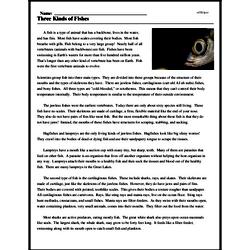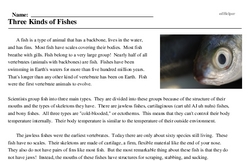Three Kinds of Fishes
A fish is a type of animal that has a backbone, lives in the water, and has fins. Most fish have scales covering their bodies. Most fish breathe with gills. Fish belong to a very large group! Nearly half of all vertebrates (animals with backbones) are fish. Fishes have been swimming in Earth's waters for more than five hundred million years. That's longer than any other kind of vertebrate has been on Earth. Fish were the first vertebrate animals to evolve.
Scientists group fish into three main types. They are divided into these groups because of the structure of their mouths and the types of skeletons they have. There are jawless fishes, cartilaginous (cart uhl AJ uh nuhs) fishes, and bony fishes. All three types are "cold-blooded," or ectotherms. This means that they can't control their body temperature internally. Their body temperature is similar to the temperature of their outside environment.
The jawless fishes were the earliest vertebrates. Today there are only about sixty species still living. These fish have no scales. Their skeletons are made of cartilage, a firm, flexible material like the end of your nose. They also do not have pairs of fins like most fish. But the most remarkable thing about these fish is that they do not have jaws! Instead, the mouths of these fishes have structures for scraping, stabbing, and sucking.
Hagfishes and lampreys are the only living kinds of jawless fishes. Hagfishes look like big slimy worms! They crawl into the bodies of dead or dying fish and use their sandpapery tongue to scrape the tissues.




